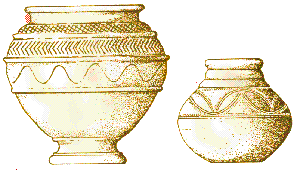The Coritani south of the Humber
The Greek geographer Ptolemy identified the Parsi tribe living north of the Humber and the Coritani south of the Humber around 300 BCE (the Iron age). Whereas the northern tribe were identified by their burials, the southern were identified by coinage and settlements.
Their domestic and mixed agricultural economies were largely similar. Evidence at Dragonby, near Scunthorpe indicates that circular huts stood in small rectangular plots each surrounded by drainage ditches. South Ferriby was probably a trading centre linked to North Fernby on the north bank of the Humber. Surface finds also suggest a settlement at Kirmington.
The village huts probably had timber and clay walls with conical thatched roofs. A ditched enclosure was excavated at Weelsby Avenue, Grimsby with two round huts and a square one which may have been a granary. There were smaller farmsteads housing one or two families as well. Iron slag at Grimsby and Dragonby suggest blacksmiths at work. Animals bones of cattle, sheep and pig are easily revealed during excavations, while droveways and animal pens are detected from the air. Aerial photographs also reveal many small enclosure sites. Seeds and pollen show that wheat and barley were grown, just as in the Bronze Age in small square fields.
Iron currency bars were used by the Coritani perhaps before the introduction of coinage. Four bars were found at Frodingham near Scunthorpe. But coins were important to the Coritani, in great contrast to the Parsi who bartered without coinage.  Two hoards of GalIic coinage from about 50 BCE (the earliest brought to south-east England by Belgic settlers from Gaul around 150 - 100 BCE) were found at Grimsby and later Coritanian designs were found at South Ferriby. They are found all around the East Midlands. After circa 50 BC, the Coritani produced silver coins with a boar with bristling crests on the front and a horse on the reverse. Later coins contained shortened names, sometimes in pairs, perhaps of chieftains or magistrates.
Two hoards of GalIic coinage from about 50 BCE (the earliest brought to south-east England by Belgic settlers from Gaul around 150 - 100 BCE) were found at Grimsby and later Coritanian designs were found at South Ferriby. They are found all around the East Midlands. After circa 50 BC, the Coritani produced silver coins with a boar with bristling crests on the front and a horse on the reverse. Later coins contained shortened names, sometimes in pairs, perhaps of chieftains or magistrates.
Coritani pottery was also more sophisticated than the plain pots north of the Humber. After about 100 BCE, they were more often made on a wheel.  The surface was rubbed to a smooth finish before firing to give a lustre effect with areas of curves and linear designs. From the late first century BCE, imports from south-east England and the continent were copied.
The surface was rubbed to a smooth finish before firing to give a lustre effect with areas of curves and linear designs. From the late first century BCE, imports from south-east England and the continent were copied.
Despite their sophistication, the people south of the Humber kept no written records. The Romans did, and reached the Coritani territory at 47 CE. It was only in 71 CE that they crossed the Humber. The celtic culture of the area was lost as the Romans forced more productivity in order that taxes were paid and the old regime's patronage was wiped away.
 Two hoards of GalIic coinage from about 50 BCE (the earliest brought to south-east England by Belgic settlers from Gaul around 150 - 100 BCE) were found at Grimsby and later Coritanian designs were found at South Ferriby. They are found all around the East Midlands. After circa 50 BC, the Coritani produced silver coins with a boar with bristling crests on the front and a horse on the reverse. Later coins contained shortened names, sometimes in pairs, perhaps of chieftains or magistrates.
Two hoards of GalIic coinage from about 50 BCE (the earliest brought to south-east England by Belgic settlers from Gaul around 150 - 100 BCE) were found at Grimsby and later Coritanian designs were found at South Ferriby. They are found all around the East Midlands. After circa 50 BC, the Coritani produced silver coins with a boar with bristling crests on the front and a horse on the reverse. Later coins contained shortened names, sometimes in pairs, perhaps of chieftains or magistrates. The surface was rubbed to a smooth finish before firing to give a lustre effect with areas of curves and linear designs. From the late first century BCE, imports from south-east England and the continent were copied.
The surface was rubbed to a smooth finish before firing to give a lustre effect with areas of curves and linear designs. From the late first century BCE, imports from south-east England and the continent were copied.